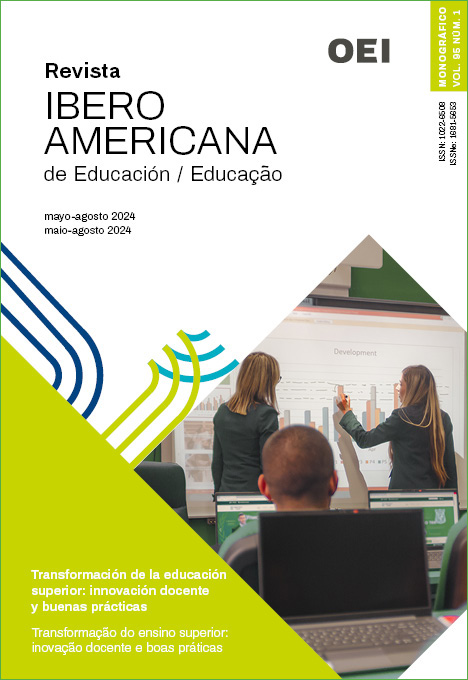Flipped classroom in higher education. Analysis of a research methods course in Educational Psychology
DOI:
https://doi.org/10.35362/rie9516268Keywords:
Flipped classroom, Educational innovation, Educational psychology, Active learning methodologiesAbstract
The need for educational innovation was strengthened due to the confinement generated by the pandemic. Since then, some existing teaching and learning methodologies have improved, such as the Flipped Classroom, which, unlike a “traditional” approach, allows active participation by students and can be applied in face-to-face environments. online or hybrid scenarios. The objective of this work is to analyze an experience of applying the Flipped Classroom in a research methods course in educational psychology. In addition to the application of this approach, this experience includes the perception of the students through a quantitative questionnaire and interviews through focus groups. 39 undergraduate students in Educational Psychology participated. The results of the application of the flipped classroom indicate, on the part of the students, that there is greater participation, self-regulation is favored, and they have a positive perception of the flipped classroom considering both advantages and disadvantages of its application. Regarding teaching, educational innovation is achieved since active methodologies were used, supported by new technologies and suggestions were obtained for the subsequent use of this approach in higher education.
Downloads
References
Arráez, G., Lorenzo Lledó, A., Gómez, M., & Lorenzo Lledó, G. (2018). La clase invertida en la educación superior: percepciones del alumnado. INFAD Revista de Psicología, 1(1), 155–162. DOI: https://doi.org/10.17060/ijodaep.2018.n1.v2.1197
Arriaga, O. G., & Lara, P. del C. (2023). La innovación en la educación superior y sus retos a partir del COVID-19. Revista Educación. https://doi.org/10.15517/revedu.v47i1.51979 DOI: https://doi.org/10.15517/revedu.v47i1.51979
Creswell, J.W. (2014). Research Design. Qualitative, quantitative and mixed methods approaches (4a ed.). Thousands Oaks, CA: Sage.
Faraone, K. L., Garrett, P. H., & Romberg, E. (2013). A blended learning approach to teaching pre-clinical complete denture prosthodontics. European Journal of Dental Education, 17(1). https://doi.org/10.1111/j.1600-0579.2012.00753.x DOI: https://doi.org/10.1111/j.1600-0579.2012.00753.x
Fidalgo, Á., Sein-Echaluce, M. L., & García-Peñalvo, F. J. (2019). ¿Qué es el método de innovación educativa denominado aula invertida? Una visión conceptual. https://doi.org/10.5281/zenodo.3520014
González, M. O., & Gaytán, P. H. (2019). A flipped classroom experience to promote prosumer students of the higher level. RIED-Revista Iberoamericana de Educacion a Distancia, 22(2), 245–263. https://doi.org/10.5944/ried.22.2.23065 DOI: https://doi.org/10.5944/ried.22.2.23065
King, A. (1993). From Sage on the Stage to Guide on the Side (Vol. 41, Número 1). Winter. DOI: https://doi.org/10.1080/87567555.1993.9926781
Lage, M. J., Platt, G. J., & Treglia, M. (2000). Inverting the classroom: A gateway to creating an inclusive learning environment. Journal of Economic Education, 31(1), 30–43. https://doi.org/10.1080/00220480009596759 DOI: https://doi.org/10.1080/00220480009596759
López, D. M., Castro, G. F., Ruiz, N. C., & Martillo, I. A. (2020). Implementación de flipped classroom enfocado a los estudiantes de Ingeniería de software: caso universidad ecuatoriana. Revista científica ecociencia, 7(3), 1–18. https://doi.org/10.21855/ecociencia.73.311 DOI: https://doi.org/10.21855/ecociencia.73.311
Díaz, S. L., Lombaerts, K., & Lizárraga, C. (2017). Flipped classroom method as a strategy to promote active learning in physics students at university level. Am. J. Phys. Educ, 11(2). http://www.lajpe.org
Maldonado, M. J., Agudelo, S., Upegui, D., & Becerra, N. (2021). Aula invertida en Pediatría: percepción de estudiantes de Medicina durante la pandemia de Covid-19. European Journal of Health Research, 1–9. https://doi.org/10.32457/ejhr.v7i2.1437 DOI: https://doi.org/10.32457/ejhr.v7i2.1437
Martínez, W. Esquivel, I., & Martínez-Castillo, J. (2014). Aula Invertida o Modelo Invertido de Aprendizaje: origen, sustento e implicaciones. En I. Esquivel (Ed.), Los Modelos Tecno-Educativos, revolucionando el aprendizaje del siglo XXI (Primera, pp. 143–160). DSAE-Universidad Veracruzana. https://go.oei.int/2rhxsoax
Mercado López, E. P. (2020). Limitaciones en el uso del aula invertida en la educación superior. Transdigital, 1(1). https://doi.org/10.56162/transdigital13 DOI: https://doi.org/10.56162/transdigital13
Nishigawa, K., Omoto, K., Hayama, R., Okura, K., Tajima, T., Suzuki, Y., Hosoki, M., Shigemoto, S., Ueda, M., Rodis, O. M. M., & Matsuka, Y. (2017). Comparison between flipped classroom and team-based learning in fixed prosthodontic education. Journal of Prosthodontic Research, 61(2), 217–222. https://doi.org/10.1016/j.jpor.2016.04.003 DOI: https://doi.org/10.1016/j.jpor.2016.04.003
Pertuz, S. (2021). Percepción de estudiantes de ingeniería sobre la enseñanza remota mediante la estrategia de aula-invertida. Revista Ingenierías Universidad de Medellín, 20(39), 231–250. https://doi.org/10.22395/rium.v20n39a13 DOI: https://doi.org/10.22395/rium.v20n39a13
Ponce, S. L., Marichal, A., Martínez, G., Soldini, M., & Darío Ponce, R. (2016). Universitaria: posibilidades para la obtención de aprendizajes no superficiales.
Sams, A., Bergmann, J., Daniels, K., Bennett, B., & Marshall, H. W. (2012). ¿Qué es el “aprendizaje invertido” o flipped learning? www.flippedlearning.com/definition
Sandobal, V. C., Bianca, M., & Barrios, T. H. (2021). The flipped classroom as a didactic strategy to build competencies: A systematic review. En RIED-Revista Iberoamericana de Educacion a Distancia, 24(2), 285-308. https://doi.org/10.5944/ried.24.2.29027 DOI: https://doi.org/10.5944/ried.24.2.29027
Tlalpachicatl, N. [El Profe Nico]. (11 de noviembre de 2022). ¿Qué es medir? ¿Qué son las Variables? ¿Cuáles son los niveles de medición? [Archivo de video]. Youtube. https://youtu.be/xRRoVKagb6g?si=kuB_GV-ro94D_uDh
Tlalpachicatl, N. [El Profe Nico]. (9 de agosto de 2023). ¿Qué es medir? ¿Qué son las Variables? ¿Cuáles son los niveles de medición? [Archivo de video]. Youtube. https://youtu.be/vpeEkUfrvyg?si=kFhcPML2Lj-S5Xs4
Tlalpachicatl, N. (26 de agosto de 2023). Video interactivo para identificar Niveles de Medición. https://go.oei.int/gbjmexe3
Tlalpachicatl, N. (14 de septiembre de 2023). Ejercicio interactivo para identificar Diseños de investigación. https://go.oei.int/xs9bqqjn
How to Cite
Published
Issue
Section
License
Copyright (c) 2024 Iberoamerican Journal of Education

This work is licensed under a Creative Commons Attribution 4.0 International License.
Any authors who publish with this journal accept the following terms:















